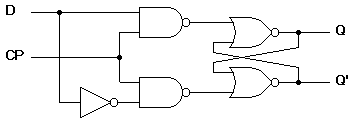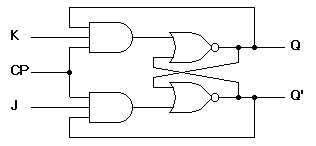memory elements of sequential circuits are called flip-flops.
flip-flops have 2 outputs:
- normal and
- complement
different kinds of Flip-Flop Circuits
A flip-flop circuit can be constructed from two NOR gates:

Each has two outputs, Q and Q', and two inputs, set and reset. This type of flip-flop is referred to as an SR flip-flop or SR latch.
two useful states:
- When Q=1 it is set (1 state).
- When Q=0 it is clear (0 state).
In normal operation must avoid putting 1 on both inputs simultaneously.
or two NAND gates:

operates with inputs normally at 1 unless the state of the flip-flop has to be changed.
0 applied momentarily to the set input causes Q to go to 1 putting the flip-flop in the set state.
In normal operation must avoid putting 0 on both inputs simultaneously.
D Flip-Flop

D type flip flip is a modification of SR flip-flop.
D input sampled during occurrence of clock pulse.
If it is 1, the flip-flop is set
If it is 0, the flip-flop is clear
JK Flip-Flop
JK flip-flop is refinement of SR flip-flop in that the indeterminate state of the SR type is defined in the JK type.
Inputs J and K behave like inputs S and R to set and clear the flip-flop
the letter J is for set and the letter K is for clear
When logic 1 inputs are applied to both J and K simultaneously, the flip-flop switches to its complement state, ie., if Q=1, it switches to Q=0 and vice versa.
A clocked JK flip-flop: 
Output Q is ANDed with K and CP inputs so that the flip-flop is cleared during a clock pulse only if Q was previously 1.
Similarly, ouput Q' is ANDed with J and CP inputs so that the flip-flop is set with a clock pulse only if Q' was previously 1.
because of the feedback connection in the JK flip-flop, a CP signal which remains a 1 (while J=K=1) after the outputs have been complemented once will cause repeated and continuous transitions of the outputs. To avoid this, the clock pulses must have a time duration less than the propagation delay through the flip-flop. The restriction on the pulse width can be eliminated with a master-slave or edge-triggered construction.
T type Flip-Flop
T type flip-flop is single input version of JK flip-flop (both inputs connected together).
Introduction - Master-Slave Flip-Flop
A master-slave flip-flop is constructed from two seperate flip-flops: 
master flip-flop enabled on positive edge of clock pulse CP and slave flip-flop disabled by inverter.
When pulse returns to 0, master flip-flop disabled and slave flip-flop enabled.
slave flip-flop then goes to the same state as the master flip-flop.
The output state of the master-slave flip-flop occurs on the negative transition of the clock pulse.
Some master-slave flip-flops change output state on the positive transition of the clock pulse by having an additional inverter between the CP terminal and the input of the master.
 ශිල්ප 64
ශිල්ප 64